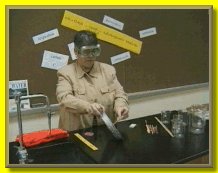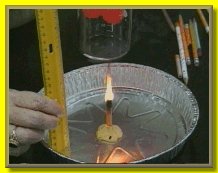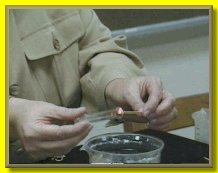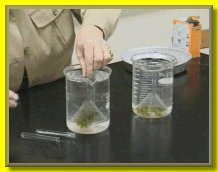Activity 3.3 Eating Air
Teacher Background:
Getting "back to (the chemical) basics" of rainforest plants and trees can make a major contribution to science education by addressing two pervasive misconceptions: that plants "eat sunlight, and that plants only take in CO2 and give out oxygen. And giving carbon a starring role in what happens in forest and industrial world alike, can help students understand what's happening locally as well as globally.
To get started--ask your students where the wood in rainforest trees (or any tree for that matter) comes from? Most will say it comes from nutrients in the soil, minerals, and water in the presence of sunlight. They may say this process gives off oxygen which produces the atmosphere we animals need to breathe. What's wrong--or at least only partially correct--about these statements? We are what we eat. But we, unlike plants, are not primary producers. Humans and other animals are dependent on the work of plants. So what is the food of trees and plants? Neither water nor minerals are "food." Webster’s New International Dictionary defines food as one of three types of complex organic substances. Organic molecules are carbon compounds (molecules that contain carbon and hydrogen atoms are called "organic.") There is nothing in these definitions about sunlight. The Dictionary goes on to say, "The food of plants consists of complex carbohydrates constructed within the bodies of green plants by photosynthesis..." Photosynthesis is the process of making food, an organic molecule. Wood is made from plant food, but plants make that food themselves.
Let's think about that from the perspective of the underlying chemistry. When we talk about water we describe a molecule of two hydrogen atoms and one oxygen atom. But these words refer to atoms, not the energy that bonds the atoms together. Wood is mainly a carbohydrate called cellulose (chemical formula, C6 H10 O5). Compare the mass of these atoms: carbon is about 12 mass units, oxygen about 16, and hydrogen about 1. Thus carbon and oxygen contribute 72 (6 x 12 for the carbon) plus 80 (5 x 16 for the oxygen) mass units while hydrogen contributes only 10 (10 x 1) units. Thus carbon and oxygen make up 152/162 of the cellulose molecule by mass. And experiments using tagged markers have shown that this oxygen comes from the carbon dioxide molecule not from the water molecule. And the carbon is not entering the plant in minerals, or in the water, but rather from the air.
Carbon dioxide enters plant leaves as a gas. It is combined with hydrogen from water to produce carbohydrates. In this process of photosynthesis, oxygen gas is produced as a by-product of the reaction. If wood is mostly carbon and oxygen, then wood comes mainly from air! That rather unexpected point should get students attention: the mightiest redwood, or rainforest giant, is made mostly of elements derived from air. These first two Activities use something readily available, a pencil, and something less easy to obtain--dry ice--to show students how carbon behaves as it changes from a solid to a gas.
|
 |
Objectives:
Students will experiment with the release of carbon from a pencil, and demonstrate its ready dissolution into air.
Students will show that dry ice and water ice differ primarily in how carbon dioxide behaves as it moves from a solid to a gas.
Students will generalize that it may be possible to move carbon back out of air and into a solid.
Standards, Goals, Benchmarks:
1.1.2 Knows that water can be a liquid or a solid and can be made to change from one form to the other, but the amount of water stays the same
1.2.1 Knows that water can change from one state to another (solid, liquid, gas) through various processes (e.g., freezing, condensation, precipitation, evaporation)
Materials:
pencils
5 glass plates or lab flasks
4 pie tins
dry ice, "water" ice
Vocabulary:
Carbon cycle, Carbon dioxide, Photosynthesis, Respiration, Sublimation
|
 |
Activity 3.3.1 Penciling in the Carbon cycle
Engage:
Ask students: What are pencils made of? Do they burn? Students will reply that the wood or the lead is made of some carbon compound.
 |
Explore:
(Consider going outside to do this activity, and supervise carefully.)
Break a pencil in half so the stub is rather small. Use the tip end--not the eraser end. Set the small section in a lump of clay in a metal pie tin. Ignite the pencil stub. Hold a clean glass plate (or a lab flask) over the burning pencil at about 10 cm above the flame, so the glass collects a nice coating of black stuff. Use a clean piece of glass or a flask and repeat with the glass 20 cm above the flaming pencil. Repeat at 30 cm, 40 cm, 50 cm.
|
Explain:
Some students will think the soot is still there at the higher levels, but so finely dispersed that they cannot see it. Does the glass collect the same amount of carbon (soot) at each elevation? (No.) As the smoke and soot rise higher more and more of the carbon combines with oxygen to become carbon dioxide--an invisible gas.
Activity 3.3.2 Comparing Dry Ice and Water Ice
Engage:
Set a lump of dry ice in a pie tin. Have students watch what begins to happen. Set a lump of water ice in a second pie tin. Ask students what dry ice is made of. (Carbon dioxide) Some students may infer that since it's called "ice", it's made of water (Di-hydrogen oxide, a less familiar name.) Ask them to think through this hypothesis, equating something less familiar with something commonplace: if dry ice is made of water, what will we see around the base of the ice lump as it sits in a warm room?
Explore:
Give students two pie pans: one with a lump of dry ice (remind them not to touch it with bare hands!) and one with a lump of water ice. If possible, have them weigh each tin with its contents. Weigh them every five minutes, and record changes they can see taking place. (The pie pan with the dry ice will lose weight and have no puddle. The water ice will not lose much weight as most of it simply changes into a puddle of liquid water.)
Explain:
Discuss with your students how dry ice is made. Point out that it is a remarkable substance, going directly from a solid to a gas without passing through a liquid stage (sublimation.) Ask them where the atoms which formed the dry ice chunk have gone. Most students, with a little guidance, will arrive at the conclusion that carbon dioxide was packed together in the form of solid dry ice, and is now a gas in the air.
Activity 3.3.3: The Breath of Plants, and the Life of the Planet
Teacher Background:
 |
Does making plant food need sunlight? Light energy is the "force" which holds the raw materials (the atoms of the carbon, hydrogen and oxygen) together in the carbohydrate molecules synthesized during the process called photosynthesis. Research on the exact nature of photosynthesis has been challenging and we still don't understand the process completely. We do know that more energy is put into bonding atoms in the carbohydrate molecule than existed in either the carbon dioxide or the water which were the raw materials. Photosynthesis is indeed a remarkable process that is integral to the first link in all food chains and essential to life as we know it on this planet. Food is not sunlight, but food may be said to be solar powered.
Oxygen must be taken in by every living cell in all plants and animals. This life-sustaining process is called respiration. Humans mechanically move air into and out of respiratory organs called lungs during a process called breathing. When we breath, oxygen and carbon dioxide are exchanged between our lungs and blood vessels. The blood transports oxygen to all the living cells of the body and, following cellular respiration, the carbon dioxide produced is carried back to the lungs and exhaled. Plants also respire at the cellular level and like humans exchange gases between their body cells and the external environment, although they lack special breathing organs. Gases diffuse in and out through various tissue surfaces and particularly through the stomata of the leaves (which we saw during Activity 1.4.) In the well-known equation for photosynthesis shown below, plants take in water and carbon dioxide and produce food (carbohydrates) and oxygen, some of which is released into the environment.
|
6 CO2 + 12 H2O  C6H1206 (glucose) + 6 H2O + 6 02
C6H1206 (glucose) + 6 H2O + 6 02
(Note that according to the equation, for every one molecule of carbon dioxide gas that is used to make carbohydrates, one molecule of oxygen gas is produced.)
Plants photosynthesis only during hours of sunlight but they respire 24 hours a day just as animals do. Photosynthesis produces 5 to 10 times more oxygen than plants use in their own respiration so extra is generated for all other animals to use. The oxygen supply in our current atmosphere comes from the extra oxygen made during photosynthesis by green plants and other non-plant photosynthesizers like algae. If we reduce the number of photosynthesizing organisms, we run the risk of depleting the oxygen content of our air. It's estimated that the entire oxygen supply of the world's atmosphere is renewed once every 3000 years by plants. There is no other important source of free oxygen in the world and indeed the Universe, as far as we currently know.
Many students do not understand that plants respire. Most students believe that photosynthesis is the plant's way of "breathing". These Activities should help them realize that plants give off oxygen when photosynthesizing (in sunlight) and carbon dioxide in the dark. It was not until 1779 that Jan Ingen-Housz, an Austrian physician, showed clearly and for the first time that plants not only released oxygen into air, but also take oxygen from it.
Objective:
Students will determine that photosynthesizing plants give off oxygen.
Students will determine that plants in the dark (not photosynthesizing) give off carbon dioxide.
Standards, Goals, Benchmarks:
8.1.1 Knows that plants and animals need certain resources for energy and growth (e.g., food, water, light, air)
8.4.3 Understands how the processes of photosynthesis and respiration in plants transfer energy from the Sun to living systems (e.g., chloroplasts in plant cells use energy from sunlight to combine molecules of carbon dioxide and water into complex, energy-rich organic compounds, and release oxygen to the environment)
11.4.4 Understands that chemical reactions either release or consume energy (i.e., some changes of atomic or molecular configuration require an input of energy; others release energy)
Materials:
(for the class)
Bucket of water, left standing (unstirred) for a day
Baking soda
(for each group of students)
2 identical drinking glasses
2 sprigs of Elodea
Engage:
If we provide extra carbon dioxide in an experiment, we could hypothesize that we would see faster photosynthesis. What would tell us that photosynthesis is occurring? (The release of oxygen gas.) Where can we get extra carbon dioxide to test our hypothesis? Have you ever played with baking soda, or made tabletop volcanoes? What kind of gas is given off as baking soda reacts with vinegar? What gas is made in fire extinguishers, and why and how do they work? Mixing baking soda with water produces carbon dioxide, but at a slower rate. What else is needed for photosynthesis in a green plant? (sunlight and water)
Explore:
Keep a bucket of water for at least a day so that any excess oxygen dissolved in it is given off. Add a spoon full of baking soda to the water to ensure it has lots of carbon dioxide. Have students pour this water into 2 matching beakers. Put the top of 2 Elodea sprigs in the beakers and cover each sprig with an upside-down glass funnel. Place a test tube filled with water over the shaft of each funnel so the closed end sticks above the water in the glass. Be sure each test tube is entirely full of water. Secure the test tubes so the beakers so the containers can be kept overnight. Put one beaker in a light-proof cabinet and put the other container under a grow lamp or in sunlight. Keep both containers under these conditions for 24 hours. After 24 hours, measure the height of the gas collected in each test tube.
Explain:
Why did the test tube kept in light have gas collected in the closed test tube end? We cannot tell simply by looking if this gas is oxygen, but there are some simple ways to find out. Test this gas by removing the test tube from the water with thumb held tightly over the open end. If we hold the test tube horizontal and insert a wood splint that was lit but then blown out, we should see the splint flame up again if the gas is oxygen. If the gas is carbon dioxide we will see any glowing spark snuff out. Try it--you will see the glowing splint burst into flame. The gas produced by the plant in sunlight is oxygen. You should find that the plant kept in darkness generated much less gas--if any.
Suggested URLs:
What is Photosynthesis?
http://photoscience.la.asu.edu/photosyn/education/learn.html
Good links from Arizona State University Photosynthesis Center
Photosynthesis
http://tqjunior.thinkquest.org/3715/photo3.html
Thinkquest site on photosynthesis written on a student level.
Classroom Videos / In-service Videos / Implementation Guide / Hands-On Activities / Worksheets / Website / National Standards





![]() C6H1206 (glucose) + 6 H2O + 6 02
C6H1206 (glucose) + 6 H2O + 6 02
![]()